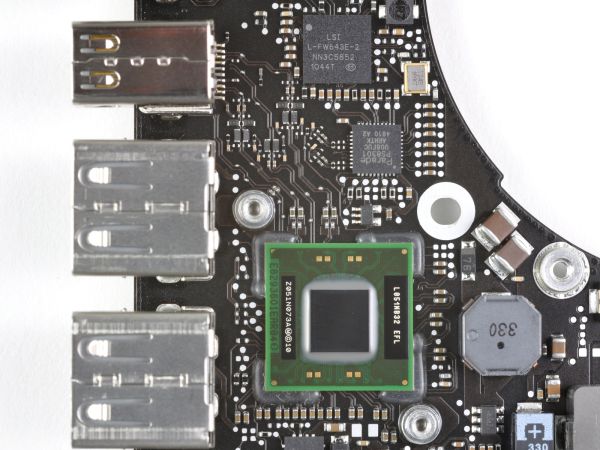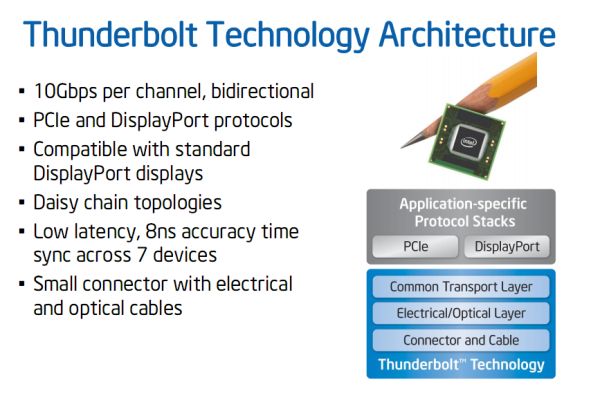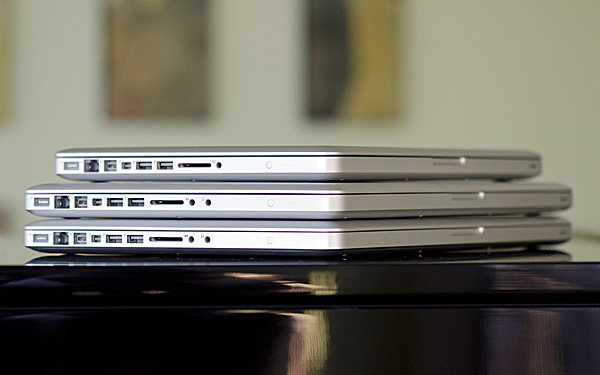Promise Pegasus R6 & Mac Thunderbolt Review
by Anand Lal Shimpi on July 8, 2011 2:01 AM ESTOne by one the barriers to mobile computing have been falling. In the early days you could move to a notebook but you'd give up a lot of CPU, GPU and I/O performance. SSDs really fixed the storage performance issue (2.5" hard drives are horrendously slow compared to their 3.5" counterparts), power gating and turbo boost helped address the CPU problem and I wouldn't be too surprised to see companies have another go at external GPU solutions for those who need the added graphics horsepower.
The idea of external GPUs brings up the current limitation we face in this mobile transition. Although being more mobile is great, we still want the best of both worlds: great performance when we're at a desk, and great battery life when mobile. Enabling the former is going to require new technologies as well as new high speed interfaces.
Intel has been at the forefront of many of the successful high bandwidth interfaces in the evolution of the PC industry. Will Thunderbolt be another feather in its cap? In February we got the first Thunderbolt enabled MacBook Pros and just last week Promise shipped the first Thunderbolt enabled storage device. It's time to put the two together.
Thunderbolt Recap
At the beginning of this year Intel, alongside Apple, finally introduced a productized version of the interface we'd previously only known as Light Peak. Given that the first instantiation of this interface used traditional copper wires and not an optical interface, Apple and Intel branded it Thunderbolt.

Thunderbolt Controller IC on 15" 2011 MacBook Pro - Courtesy iFixit
The interface is royalty free, although Intel is the only company that makes Thunderbolt controller needed to support the interface. There's no word on the cost of the Thunderbolt controller. Thunderbolt isn't an Apple exclusive, however we won't see PCs ship with the high bandwidth copper interface until 2012 at the earliest.
Thunderbolt is a high speed, dual-channel serial interface. Each channel is good for up to 10Gbps of bi-directional bandwidth (20Gbps total) and with two channels a single Thunderbolt link is enough for 40Gbps of aggregate bandwidth.

Thunderbolt can carry both PCIe and DisplayPort signaling. Apple claims that one of the channels is used for DisplayPort while the other is used for PCIe. DisplayPort interface support extends to the connector, which is physically compatible with a standard mini-DisplayPort connector. DisplayPort support is key as it allows video to be carried in addition to data, potentially allowing for some interesting use as a single cable docking solution for notebooks.
In addition to carrying up to 40Gbps of total bandwidth, a single Thunderbolt cable can also deliver up to 10W of power to connected devices.

Each Thunderbolt port can drive up to 7 daisy chained devices, although all devices must share the 40Gbps (up/down) bandwidth to the host.
There's an obvious comparison to USB 3.0 which currently tops out at 5Gbps, however even it offers only 1/4 of the total available bandwidth of the Thunderbolt PCIe channel (not to mention its inability to carry DisplayPort).











88 Comments
View All Comments
etamin - Sunday, July 10, 2011 - link
hmm, I think I'm missing something here. Are you saying that the new MBPs have 12 lanes to the dGPU because 4 have been borrowed (on demand?) by the TB controller? or does the PCH has its PCI lanes? if so, how many? Thanks for the reply.repoman27 - Sunday, July 10, 2011 - link
Anand explained it in his review of the mid 2011 iMac, here: http://www.anandtech.com/show/4340/27inch-apple-im...etamin - Monday, July 11, 2011 - link
I see...I never noticed the PCH/SB always had PCI lanes of its ownrepoman27 - Saturday, July 9, 2011 - link
"At the end of a Thunderbolt chain you can insert a miniDP display, currently the only option is the 27-inch LED Cinema Display but in theory other panels that accept a miniDP input could work as well."Any DisplayPort enabled display will work, and there's plenty of those. You just need to use an asymmetrical cable. Just like you don't need a display with a mini/micro HDMI port to use the mini/micro HDMI out on the devices that have those. Or a PC with mini/micro USB ports.
mAxius - Sunday, July 10, 2011 - link
intel and apple will have thunderbolt the rest of the planet will have external pci express and usb who will winhttp://www.eetimes.com/electronics-news/4217190/PC...
Focher - Sunday, July 10, 2011 - link
According to that article, their standard is due for mid 2013. It's slower than TB and it's not even real. They've just announced plans to make something.repoman27 - Sunday, July 10, 2011 - link
“I'm not entirely convinced that we're limited by Thunderbolt here either - it could very well be the Pegasus' internal controller that's limiting performance.”I’m pretty sure what you’ve gone and done here is bumped into the ceiling imposed by the CPUs in those Macs only supporting a PCIe maximum TLP payload size of 128 bytes. You achieved a little better than 80% of the total 10 Gbps bandwidth available on one Thunderbolt channel in actual data throughput, which is surprisingly good. Even though that bandwidth is exclusive of PCIe’s normal 8b/10b encoding overhead, there’s no getting around the additional overhead inherent to any packetized protocol. A Thunderbolt controller paired with a northbridge that supports 4096 byte payload sizes could theoretically achieve around 99% of the full 10 Gbps.
You’ve also shown that one device using a single Thunderbolt channel can use > 50% of the bandwidth of the 4 PCIe 2.0 lanes connected to the Thunderbolt controller. Thus if you connected one 4-drive SF-2281 Pegasus R6 RAID-0 to each of the Thunderbolt ports on the 2011 iMac, you still shouldn’t expect more than 12,833 Mbps combined throughput.
The Target Disk Mode results are disappointing, although you’re always limited to the speed of the slowest drive that you’re transferring to/from. You didn’t mention what the iMac was packing, but if it’s still just the 1 TB 7200 RPM Seagate that was in the model you reviewed earlier, that would be the limiting factor. Did you check to see what you could pull using FireWire Target Mode between the two?
“simply displaying an image at 60Hz on the 27-inch Cinema Display requires over 6.75Gbps of bandwidth (because of 8b/10b encoding)”
I’m guessing that the 8b/10b encoding overhead is once again not present in the 10 Gbps per channel Thunderbolt bandwidth figure, just as for PCIe packets. Otherwise Thunderbolt would not be able to fully support the DisplayPort 1.1a spec which calls for 10.8 Gbps when including the 8b/10b padding.
“Apple claims that one of the channels is used for DisplayPort while the other is used for PCIe.”
This still flummoxes me. Does that mean that if you daisy chained 2 4-drive SF-2281 Pegasus R6’s to the Thunderbolt port on the MacBook Pro that you would achieve no better than 8021Mbps combined? That neither device could use the bandwidth of the second Thunderbolt channel even with no DisplayPort device present? Also, although Thunderbolt ports only support DisplayPort 1.1a resolutions, might they still support DP 1.2 features such as MST and daisy chainable displays? Or is the only way to connect multiple displays to one Thunderbolt port by using a DP 1.1a multi-display hub and thereby limiting the resolution of at least one of them to less than 2560x1440?
LedHed - Sunday, July 10, 2011 - link
By the time we have a decent amount of devices starting to use the Thunderbolt interface this will be outdated with the 2nd revision. Once again Apple is raising the price for no gain in anyway.LedHed - Sunday, July 10, 2011 - link
Also calling that huge array box mobile is hilarious in itself.xrror - Sunday, July 10, 2011 - link
So Apple will fix all the nagging issues with Thunderbolt connectivity when... they transition to ARM. Begone evil PC people, I'm sure Apple hates it thoroughly that iMacs and MBP can be "perverted" to x86's domain of Windows.So when MacOS basically is superseded by iOS for their "non-handheld mobile devices" and they finally eliminate iMac and MBP since "people who didn't transition to our new taint-ARM/Apple specific processor" line of devices are obviously just lame, as proven by the poor saps holding on to their PowerPC macs. Yea it's coming full circle.
Ugh... I really hope I'm just being paranoid/joking. But...